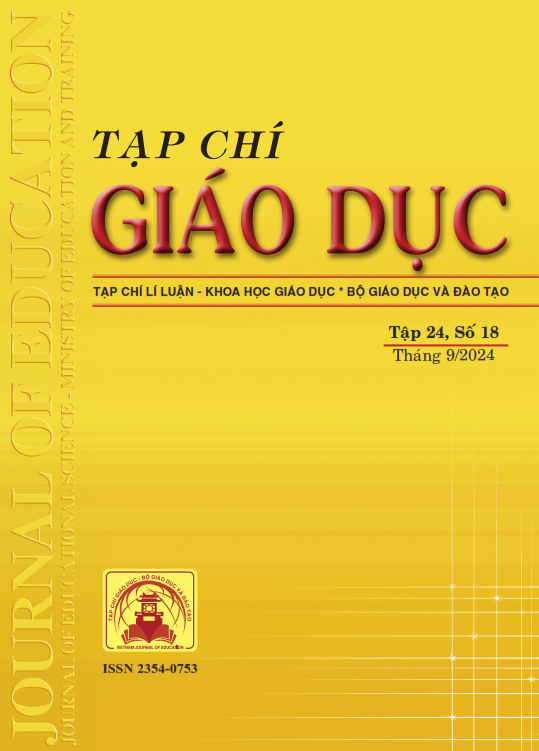Các công cụ đánh giá tương tác giữa cha mẹ với con giai đoạn 0 đến 6 tuổi và bàn luận về hướng vận dụng tại Việt Nam
Tóm tắt
In many social relationships, the interaction between parents and children plays a vital role. The family is the closest social environment for children, and parents are representatives of a social culture that regularly impacts children. Accordingly, identifying appropriate assessment methods and tools is meaningful in improving parent-child interaction skills. This article presents the results of synthesizing and analyzing interaction assessment tools between parents and children aged from 0 to 6 years old, which have been conducted by direct observation and developed since 2000. The literature review research method was used to extract studies from three databases: Google Scholar, ScienceDirect, and ProQuest. Based on the inclusion and exclusion criteria, 14 assessment tools were included in the analysis. The research results show that although they all evaluate parent-child interactions, the interactive behaviors identified in the tools are relatively diverse, and positive interactive behaviors tend to be selected rather than negative interactions. The research is the basis for experts to select, refer to, and design assessment tools to measure parents' interaction skills with their children in the Vietnamese family cultural context.
Tài liệu tham khảo
Ainsworth, M. D. S. (1973). The development of infant-mother attachment. In B. Cardwell & H. Ricciuti (Eds.), Review of child development research (Vol. 3, pp. 1-94). Chicago: University of Chicago Press.
Barnard, K. E. (1976). The Barnard model. In G. Summer & A. Spietz (Eds), NCAST caregiver/parent-child interaction feeding manual (pp. 8-14). Seattle: NCAST Publication, University of Washington School of Nursing.
Bernier, A., Dégeilh, F., Leblanc, É., Daneault, V., Bailey, H. N., & Beauchamp, M. H. (2019). Mother-infant interaction and child brain morphology: A multidimensional approach to maternal sensitivity. Infancy, 24(2), 120-138.
Biringen, Z., Moorlag, A., Meyer, B., Wood, J., Aberle, J., Altenhofen, S., & Bennett, S. (2008). The emotional availability (EA) intervention with child care professionals. Journal of Early Childhood and Infant Psychology, 4, 39-52.
Bowlby, J. (1969). Attachment and Loss. New York: Basic Books.
Bowlby, J. (1958). The Nature of the Childs Tie to his Mother. International Journal of Psychoanalysis, 39, 350-371. Carl, B. (2007). Child caregiver interaction scale . Indiana University of Pennsylvania.
Clackson, K., Wass, S., Georgieva, S., Brightman, L., Nutbrown, R., Almond, H., Bieluczyk, J., Carro, G., Dames, B. R., & Leong, V. (2019). Do Helpful Mothers help? Effects of maternal scaffolding and infant engagement on cognitive performance. Frontiers in Psychology, 10. https://doi.org/10.3389/fpsyg.2019.02661
Comfort, M., & Gordon, P. R. (2006). The Keys to Interactive Parenting Scale (KIPS): a practical observational assessment of parenting behavior. NHSA Dialog, 9(1), 22-48. https://doi.org/10.1207/s19309325nhsa0901_4
Crittenden, P. M. (2001). CARE-Index Infants Coding Manual. Family Relations Institute, Miami, FL.
Fiori-Cowley, A., Murray, L., & Gunning, M. (2000). Global ratings of Mother-Infant interaction at two and four months. In Winnicott Research Unit. United Kingdom: University of Reading Reading.
Greenspan, S. I., DeGangi, G., & Wieder, S. (2001). The Functional Emotional Assessment Scale (FEAS): For infancy & early childhood. Interdisciplinary Council on Development & Learning Disorders.
Hesse, E., & Main, M. (2006). Frightened, threatening, and dissociative parental behavior in low-risk samples: Description, discussion, and interpretations. Development and Psychopathology, 18(2), 309-343.
Jaekel, J., Pluess, M., Belsky, J., & Wolke, D. (2015). Effects of maternal sensitivity on low birth weight children’s academic achievement: a test of differential susceptibility versus diathesis stress. Journal of Child Psychology and Psychiatry and Allied Disciplines, 56(6), 693-701. https://doi.org/10.1111/jcpp.12331
Moher, D., Liberati, A., Tetzlaff, J., & Altman, D. G. (2009). Preferred reporting items for systematic reviews and meta-analyses: the PRISMA statement. BMJ. British Medical Journal, 339(1).
Out, D., Bakermans-Kranenburg, M. J., & Van IJzendoorn, M. H. (2009). The role of disconnected and extremely insensitive parenting in the development of disorganized attachment: validation of a new measure. Attachment & Human Development, 11(5), 419-443. https://doi.org/10.1080/14616730903132289
Oxford, M. L., & Findlay, D. M. (2012). NCAST Caregiver/Parent-Child Interaction Teaching Manual. NCAST Publication.
Pederson, D. R., & Moran, G. (1995). Appendix B. Maternal Behavior Q-set. In Waters E, Vaughn BE, Poseda G, & Kondo-Ikemura K (Eds.), Caregiving, cultural, and cognitive perspectives on secure-base behavior and working models: New Growing Points of Attachment Theory and Research. Monographs of the Society for Research in Child Development, 60, 247-254.
Prime, H., Wade, M., & Gonzalez, A. (2020). The link between maternal and child verbal abilities: An indirect effect through maternal responsiveness. Developmental Science, 23(3). https://doi.org/10.1111/desc.12907
Reed, C. S., Van Egeren, L. A., & McKelvey, L. (2009). Psychometric Study of The Parenting Skills Assessment. Michigan State University.
Roggman, L. A., Cook, G. A., Innocenti, M. S., Norman, V. J., & Christiansen, K. (2013). Parenting Interactions with Children: Checklist of Observations Linked to Outcomes (PICCOLO) in Diverse Ethnic Groups. Infant Mental Health Journal, 34(4), 290-306. https://doi.org/10.1002/imhj.21389
Russo, J. A. B., & Owens Jr, R. E. (1982). The development of an objective observation tool for parent-child interaction. Journal of Speech and Hearing Disorders, 47(2), 165-173. https://doi.org/10.1044/jshd.4702.165
Sylvestre, A., Brassart, E., Leblond, J., & Di Sante, M. (2021). Introducing the coding observations of parent-child interactions (COPI): An observational measure of the parental behaviours that matter for language development. Canadian Journal of Speech-Language Pathology and Audiology (CJSLPA), 1913-2020.
Van Huisstede, L., Winstone, L. K., Ross, E. K., & Crnic, K. A. (2019). Developmental trajectories of maternal sensitivity across the first year of life: Relations among emotion competence and dyadic reciprocity. Parenting, 19(3), 217-243.
Tải xuống
Đã Xuất bản
Cách trích dẫn
Số
Chuyên mục
Giấy phép

Tác phẩm này được cấp phép theo Ghi nhận tác giả của Creative Commons Giấy phép quốc tế 4.0 .












